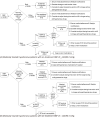2020 Consensus Statement of the Taiwan Hypertension Society and the Taiwan Society of Cardiology on Home Blood Pressure Monitoring for the Management of Arterial Hypertension
- PMID: 33235411
- PMCID: PMC7677637
- DOI: 10.6515/ACS.202011_36(6).20201106A
2020 Consensus Statement of the Taiwan Hypertension Society and the Taiwan Society of Cardiology on Home Blood Pressure Monitoring for the Management of Arterial Hypertension
Abstract
To facilitate the applications of home blood pressure (HBP) monitoring in clinical settings, the Taiwan Hypertension Society and the Taiwan Society of Cardiology jointly put forward the Consensus Statement on HBP monitoring according to up-to-date scientific evidence by convening a series of expert meetings and compiling opinions from the members of these two societies. In this Consensus Statement as well as recent international guidelines for management of arterial hypertension, HBP monitoring has been implemented in diagnostic confirmation of hypertension, identification of hypertension phenotypes, guidance of anti-hypertensive treatment, and detection of hypotensive events. HBP should be obtained by repetitive measurements based on the " 722 " principle, which is referred to duplicate blood pressure readings taken per occasion, twice daily, over seven consecutive days. The " 722" principle of HBP monitoring should be applied in clinical settings, including confirmation of hypertension diagnosis, 2 weeks after adjustment of antihypertensive medications, and at least every 3 months in well-controlled hypertensive patients. A good reproducibility of HBP monitoring could be achieved by individuals carefully following the instructions before and during HBP measurement, by using validated BP devices with an upper arm cuff. Corresponding to office BP thresholds of 140/90 and 130/80 mmHg, the thresholds (or targets) of HBP are 135/85 and 130/80 mmHg, respectively. HBP-based hypertension management strategies including bedtime dosing (for uncontrolled morning hypertension), shifting to drugs with longer-acting antihypertensive effect (for uncontrolled evening hypertension), and adding another antihypertensive drug (for uncontrolled morning and evening hypertension) should be considered. Only with the support from medical caregivers, paramedical team, or tele- monitoring, HBP monitoring could reliably improve the control of hypertension.
Keywords: Antihypertensive; Blood pressure; Home; Hypertension.
Figures


References
-
- Umemura S, Arima H, Arima S, et al. The Japanese Society of Hypertension guidelines for the management of hypertension (JSH 2019). Hypertens Res. 2019;42:1235–1481. - PubMed
-
- Whelton PK, Carey RM, Aronow WS, et al. 2017 ACC/AHA/AAPA/ABC/ACPM/AGS/APhA/ASH/ASPC/NMA/PCNA guideline for the prevention, detection, evaluation, and management of high blood pressure in adults: executive summary: a report of the American College of Cardiology/American Heart Association Task Force on Clinical Practice Guidelines. Hypertension. 2018;71:1269–1324. - PubMed
-
- Williams B, Mancia G, Spiering W, et al. 2018 ESC/ESH guidelines for the management of arterial hypertension. Eur Heart J. 2018;39:3021–3104. - PubMed
-
- Chiang CE, Wang TD, Ueng KC, et al. 2015 guidelines of the Taiwan Society of Cardiology and the Taiwan Hypertension Society for the management of hypertension. J Chin Med Assoc. 2015;78:1–47. - PubMed
-
- Park S, Buranakitjaroen P, Chen CH, et al. Expert panel consensus recommendations for home blood pressure monitoring in Asia: the Hope Asia Network. J Hum Hypertens. 2018;32:249–258. - PubMed
Publication types
LinkOut - more resources
Full Text Sources
Miscellaneous
